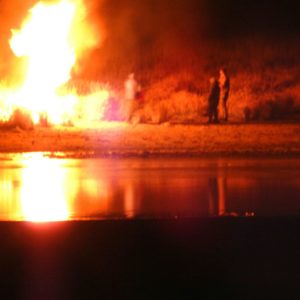Last November, as families around the country prepared for turkey dinners, protesters in North Dakota occupied three camps on the banks of the Missouri River. On the night of November 20, 2016, the uneasy peace between protesters and police was broken and the two sides clashed over control of Backwater Bridge. The altercation resulted in the severe injury of Sophia Wilansky, who was airlifted to Minneapolis for emergency surgery. One year later, details about what happened on the bridge that night are slowly coming out, but both physical and emotional scars from the altercation remain. After several delicate surgeries, Wilansky was able to keep her right arm, but has yet to regain motion in it.
On the anniversary of the bridge clash, it still resonates with locals on both sides of the conflict. Opponents of the protest see the violence on the bridge as an effect of provocation from the protesters.
“The larger point here is that the violence on the Backwater Bridge happened because the protesters provoked it. The protesters repeatedly attacked the pipeline workers and their equipment. They used trespass and vandalism and violence in persistent attempts to stop the pipeline’s construction. When the police put up road blocks and check points to try and stop the violence, the protesters attacked the police,” writes Rob Port, a political commentator from North Dakota.
“All of the injuries which happened during the #NoDAPL protests were the result of the protesters themselves creating situations in which people got hurt,” he continued. “Had the protesters been peaceful, had they restrained themselves to lawful tactics, nobody (including Wilansky) would have been hurt.”
Meanwhile, former protesters marked the anniversary of the clash as a night of terror and pain.
“Last year on this day, Dakota Access and its corporate police army attacked unarmed Oceti Sakowin and their allies at Backwater Bridge,” said Ruth Hopkins, one of the Native American protesters, who described the altercation as a day that changed her forever. “Hundreds were sprayed with mace, shot, and sprayed with a water cannon in freezing weather. It was just a few days before Thanksgiving.”
Throughout the fall, protesters and police had struggled for control over Backwater Bridge, which connected the Army Corp of Engineers’ land where the protest camps were located to the nearest highway. Protesters used a truck and chains to attempt to clear away barricades from the bridge, while law enforcement used fire hoses to try to put out several fires that the protesters had set. An explosion on the bridge sent shrapnel into Willansky’s arm. Protesters argue that this was a fragment of a shock grenade used by police, while law enforcement counters that it was a fragment of a fuel canister that the protesters were planning to use as an improvised explosive.
In June, the leaking of emails between local law enforcement, the North Dakota Attorney General’s office, the FBI, and private security hired by the pipeline company showed that this information came from an FBI source in the camp. According to this source, protesters were rigging propane tanks to explode.
To date, the FBI has not released official findings on the incident, though an investigation is ongoing. Earlier this year, they also sought evidence that Wilansky had broken federal explosive laws. They also seized the shrapnel that was removed from her arm and the clothes that she was wearing at the time.
Native American activists are arguing that the State’s Attorney should drop all charges against the protesters. They presented the Morton County State’s Attorney’s Office on Tuesday with a petition of more than 55,000 physical and digital signatures pushing for charges to be dropped.
“The crimes and the acts of war that occurred a year ago today is why we’re commemorating today and we’re putting forth the petition for dismissal of the additional charges that people are facing in the court system,” said LaDonna Brave Bull Allard, one of the protesters.
Although some court cases remain, most protest energy has shifted away from Standing Rock. The anniversary comes at a tense moment for Native American environmentalists. On Monday, the state of Nebraska announced its approval of the Keystone XL pipeline, albeit on a modified route. Many of the protest leaders have moved to Nebraska, where a new camp, Wakpa Waste, is forming to protest the proximity of the proposed pipeline to the Cheyenne River Sioux reservation.
Though the Wakpa Waste camp has yet to attract more than a few dozen people, the memories of Standing Rock are on everyone’s minds. Despite being unsuccessful, the protests in North Dakota last year have left a strong cultural impact.
They have also left a political one. In late September, Dave Archambault II lost his seat as Standing Rock’s tribal chairman. The tribe’s vice chairman and two other councilmembers also lost their seats. The election was viewed by many as a referendum on Archambault’s handling of the protests, though the new chairman, Mike Faith, says that his decision to run did not have anything to do with the pipeline camp.
The campaign stressed local issues, including drug abuse and the economy. The reservation has suffered in the wake of the protests, which blocked traffic to the Prairie Knights Casino, one of its major employers, for several months. Revenues for the casino decreased by $6 million between 2015 and 2016.
The construction of the Dakota Access pipeline is complete, but in many ways, the work of rebuilding after the Standing Rock protests still continues today. The events on Backwater Bridge last year demonstrated the acrimony that had developed between both sides of the pipeline issue. Those scars, like the gouges left in the prairie after the protesters’ trucks had gone, are still fading.

